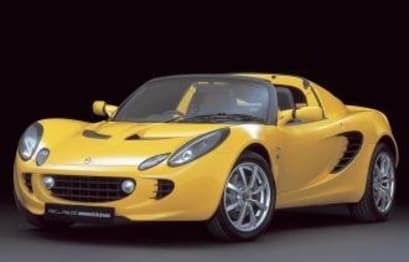
Lotus Elise 2005 Review
- Lotus Elise
- Lotus Elise 2005
- Lotus Elise Reviews
- Lotus Reviews
- Lotus Convertible Range
- Lotus Coupe Range
- Convertible
- Coupe
- Lotus

Hamburgers, though only very occasionally eaten, were totally out. No pies, fish and chips, milkshakes and even the beer was looking redundant.
The sacrifice worked. Like the car I was to drive, the fat — well, a bit of it — had been sliced away to mimic the automobile as a work of minimalistic art.
Which is an art in itself, given that Lotus started with one of the barest cars on the market — its Elise — and then cut, lightened and simply threw away parts until it produced a mechanical ultralight.
The 340R is so named because Lotus intended to make a sports car with a formidable power-to-weight ratio of 340bhp a tonne. It actually failed to produce that ratio from the factory, but pacified the critics by making only 340 cars — which was Lotus's original plan.
Though conflicts between the stylists and the engineers from Lotus and the British transport authorities meant that alluring power-to-weight ratio did not
materialise on the showroom floor, a few owners did even better.
This car, with its subdued alloy and black skeleton, has 352bhp a tonne.
It is rare, not only because it surpasses the manufacturer's aims, but also because it is only one of three in Australia.
Brought in by Lotus Cars Australia to be the display car at the 2000 Sydney International Motor Show, it was the 337th made. But if Lotus didn't fulfil its desire to build 340 cars, it could even be the last.
It was also the only one imported into Australia that was fully optioned with the 145kW kit, carbon-fibre mudguards, techno-magnesium alloy wheels, removable steering wheel, and six-point racing harness.
Sold after the motor show to a Sydney dentist for $140,000, it was bought by a WA lawyer in 2003. It's now for sale again.
Since its journey to Perth, there have been further upgrades such as boosting power to 160kW at the flywheel and 140kW at the rear wheels.
Together with some weight-saving components, it's enough to get this 340R from rest to 100km/h in a tad under four seconds. In perspective, that's faster than a Porsche 911 Turbo (4.2sec) and the Ferrari 430 (4sec).
But it's also lighter — the test car weighs about 610kg and was 658kg out of the factory — and loses a few creature comforts. Like the doors, windows, roof, sound system, airconditioning, carpets, and so on.
You learn to live without all that. If it rains, go faster. If the sun is burning your pate, wear a hat. If it's freezing then you're a whinger and don't deserve to own a car like this.
It also has no numberplates, saving even further weight though that can cause some angst among the constabulary.
The 340R was never built to meet Australian Design rules, so this one gets around to motorsport events on a 12-month renewable permit.
The modified Rover K-series 1.8-litre four-cylinder engine — also used in various stages of tune in vehicles including the Land Rover Freelander, Rover 45, MGTF, Metro and Caterham Seven — sits behind the driver and pumps away through a close-ratio five-speed gearbox to drive the 16-inch rear wheels.
The driver sits within a bonded aluminium chassis topped by a composite shell shaped something like a wedge-toed shoe.
The seats are lightweight composite racing units to hug the body, and the cockpit side panels are translucent polycarbonate sheet, giving occupants a surreal blurred view of the passing road.
Get in by sitting on the side panels, swinging the legs over and dropping into the seat. The steering wheel is tiny, the 8000rpm tacho glares back at you, the view ahead is clear and to the side, completely unobstructed. I'm feeling very vulnerable.
The six-point harness is a pain for driving on the road, yet I note it clicks easily into place thanks to the previous week of dieting.
De-activate the alarm and immobiliser, press the central alloy starter button and all hell breaks lose.
Every blip of the throttle vibrates up my spine, the noise tears at my ears and the blast of hot air burns my neck.
Release the light clutch and plant the alloy accelerator pedal to the floor, and the engine burble swells to a roar, then a scream.
Then, with the tiny tacho needle closing on 8000rpm, slam the clutch open and flick the longish gearlever back into second. It fires forward again, the tacho needle dancing and the need for third gear coming up real quick.
Brake for the corner, feel how light the front of the car is and deliberately pick an accurate line through the corner. That, says the owner, is important because it's not shy about flicking the tail out.
Faster and faster around the racetrack, the 340R gets to know its driver. The tail comes up a bit, the nose starts to slide a fraction, but it's all easily controlled.
Stop. Breathe. Turn on "launch control" — a computer-controlled method of getting this little beast off the line even faster.
Click into first gear, plant your foot on the accelerator — don't worry, the computer won't let you exceed 5500rpm — then drop the clutch.
Your neck takes up the slack in the acceleration as the computer ensures that the engine delivers maximum power with minimal wheelspin. Brilliant.
Can I have a beer now, please?
Pricing guides
Range and Specs
| Vehicle | Specs | Price* | |
|---|---|---|---|
| Sport 111 | 1.8L, ULP, 5 SP MAN | $13,420 – 17,600 | 2005 Lotus Elise 2005 Sport 111 Pricing and Specs |
| (base) | 1.8L, PULP, 5 SP MAN | $8,800 – 12,320 | 2005 Lotus Elise 2005 (base) Pricing and Specs |
| 111R | 1.8L, ULP, 6 SP MAN | $19,800 – 25,080 | 2005 Lotus Elise 2005 111R Pricing and Specs |
| S | 1.8L, PULP, 5 SP MAN | $8,140 – 11,440 | 2005 Lotus Elise 2005 S Pricing and Specs |
$8,140
Lowest price, based on third party pricing data







